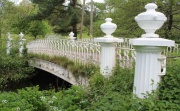White Bridge, Oxton House
'The White Bridge' is an iron bridge crossing a stream on the approach to Oxton House, near Kenton, south of Exeter.
The bridge is Grade II star listed, and is well-described in the listing text:-
'.....An unusual design; cast iron beam construction. Single span with cambered arched beams and ornate cast iron balustrades fixed to paired squat cast iron fluted Doric columns at each end, the columns crowned with vase finials and supported on stone piers with cornices.....'[1]
The overall appearance is most impressive and unusual, especially with regard to the fluted columns for the balustrades, and the cambered cast iron beams with a pattern of laurel wreaths. Unfortunately there is no suitable viewpoint to obtain the full benefit of the designer's and ironfounders' work.
The bridge is on a narrow, winding road leading to Oxton House (see maps here).
The date is given in the Grade II Star listing as c.1830. However, although the appearance shouts 'Georgian', two other factors whisper 'Victorian'. One is somewhat subjective - the style of the attached nameplates bearing the words 'J. VICKARY EXETER'. The other is the fact that J. Vickary appears not to have established his iron foundry until the mid to late 1850s.
This prompted further investigation, which has shown that ornamental cast iron girders for the bridge were made by Martin and Parkin of Exeter in 1856 (see below). It may be that J. Vickary was the contractor for the bridge, and sub-contracted some or all the iron castings to Martin and Parkin. We know that he had done this in connection with gas works castings in 1852 (see J. Vickary). This make explain why Vickary's name is on separate nameplates, rather than cast in.
1856 Article: 'Ornamental Castings.— During last week, Messrs. Martin and Parkin, iron founders of the Bonhay, finished two ornamental cast-iron girders for a bridge in the lawn of General Studd, Oxton House, Mamhead. The length of the girders are 36 feet each, of an elegant pattern, and each weighs 2¼ tons. These castings have been much admired by many engineers and others and as they are the largest that have ever been attempted in this county, reflect great credit on our spirited and enterprising citizens.'[2]
Note that only two girders are mentioned. There are three. Perhaps the centre girder, not being ornamented, did not attract the same degree of admiration.






